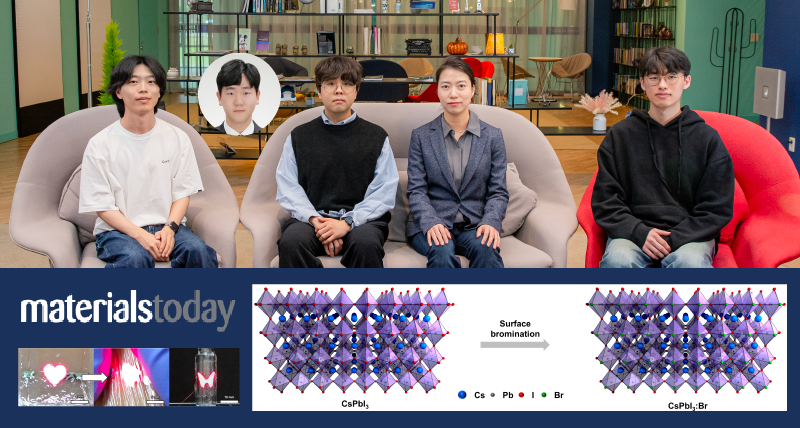In a groundbreaking collaboration between Professor Moon Kee Choi’s research team from the Department of Materials Science and Engineering at UNIST and Professor Jiwoong Yang’s team from the Department of Energy Science and Engineering at DGIST, a significant advancement in wearable display technology has been achieved. This pioneering research focuses on the development of pure red, high-performance skin-attached perovskite light-emitting devices (PeLEDs) with exceptional efficiency and stability. Their findings offer promising prospects for the future of wearable displays and optoelectronic materials, marking a significant step towards the advancement of next-generation technologies.

Figure 1. Schematic illustration depicting the atomic structure of CsPbI3 PeNCs before and after the surface bromination.
With the recent growth of wearable, mobile, and Internet of Things (IoT) technologies, demand for wearable displays is increasing. In particular, perovskite light emitters, which are mainly used in solar cells and light emitting devices, are attracting attention as next-generation optoelectronic materials, and research on wearable displays using them is actively being conducted due to their low cost, efficient solar conversion, and light emitting effects.
However, the existing red perovskite material was not suitable for use as a high-performance wearable display due to its low stability and electrical properties. Accordingly, the joint research team of DGIST-UNIST succeeded in manufacturing a pure red light emitting device with excellent safety and electrical characteristics by simple surface modification of the perovskite emission layer.

Figure 2. (left) EL emission spectra of PeLEDs employing CsPbI3 and T-CsPbI3:Br PeNCs. (center) J-V-L curves of CsPbI3, CsPbI3:Br, and T-CsPbI3:Br PeNC-based PeLEDs. Triangles and circles are employed to represent the J-V and V-L curves, respectively. (right) EQE versus current density curves of CsPbI3, CsPbI3:Br, and T-CsPbI3:Br PeNC-based PeLEDs
Metal halide perovskites have long been recognized for their exceptional optical properties, including high photoluminescence quantum yield and tunable bandgap, making them highly promising for next-generation display technologies. The research team introduced a novel surface bromination strategy for CsPbI3 PeNCs, resulting in the creation of CsPbI3:Br PeNCs with bright pure red luminescence and improved electrical properties. By fabricating PeLEDs with these surface-brominated PeNCs, the team achieved a remarkable external quantum efficiency (EQE) of 19.8%, on par with the best reported pure red PeLEDs.
Moreover, the application of these advanced PeLEDs as skin-attachable devices showcased their stable operations under various mechanical deformations, highlighting their potential for wearable electronic applications. This study not only presents a straightforward method for producing pure red PeNCs but also underscores their significance in wearable display technologies.

Figure 3. Schematic of ultrathin skin-attachable PeLEDs. Photographs of ultrathin skin-attachable PeLEDs on human skin in flat (left) and wrinkled (right) state. (right) Photograph of ultrathin PeLEDs conformally attached to the surface of a glass vial.
Professor Yang from DGIST emphasized the importance of surface modification in enhancing stability and electrical properties, ultimately leading to the impressive EQE achieved in this study. The research team envisions the commercialization of pure red perovskite displays for a wide range of applications, including VR, AR, and smart wearable devices.
Supported by the Ministry of Science and ICT, the Korea Research Foundation, and the Pohang Accelerator Research Institute, the results of this innovative research have been published in the online April 2024 edition of Materials Today.
Journal Reference
Kyunghoon Lee, Yunho Kim, Eonhyoung Ahn, et al., “Highly efficient pure red light-emitting diodes through surface bromination of CsPbI3 perovskite nanocrystals for skin-attachable displays,” Materials Today, (2024).













